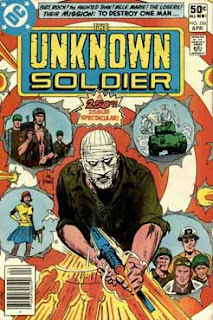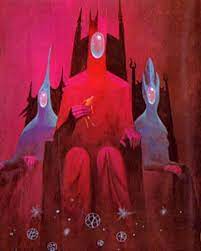I'm reading DC Comics' output from January 1980 (cover date) to Crisis! I'm a couple of days later than my usual Wednesday post, but I'm looking at the comics at newsstands on the week of January 8, 1981.
Batman #334: All our heroes finally meet the villainous mastermind and it's Ra's Al Ghul, surprising no one. Batman glimpses the Greek-robed followers of Al Ghul living in some sort of garden, while people who displease him toil in some hellish mine. Robin, Catwoman, and King Faraday, are placed there, but manage to make a break for it. Talia does a heel turn to keep herself young and our heroes are recaptured. Al Ghul gives Batman an ultimatum: join up and get immortality, or don't and all the heroes die.
There are two backups here. There's a Commissioner Gordon one-pager by Rozakis and Staton where Gordon gets so show off his deductive reasoning chops. Then, there's "Tales of Gotham" by Barr and Spiegle starring Jason Bard. Bard's hired by a woman to find out who burned down her house. It winds up being her ex-husband, looking to collect insurance money.
DC Comics Presents #32: "The Super-Prisoners of Love." Mischievous Cupid makes Wonder Woman and Superman fall for each other. Their response is to try to keep their distance--Superman knocks a hole through the JLA satellite after accidentally touching Diana's hand! But when Wonder Woman sees Superman kissing Lois she flips out and starts a fight. Finally, they go to confront Cupid, but they have to go on a quest and fight a Minotaur before they can acquire the blue lotus that will counteract the charm. Conway and Schaffenberger are responsible for this silliness.
The "Whatever Happened to Back-Up" is sort of interesting because it's about Mark Merlin and Prince Ra-Man, a character I saw die in Crisis, but otherwise knew nothing about. This story has Elsa, Merlin's love interest and secretary, discovering that Ra-Man is actually Merlin's spirit reincarnated in the body of an ancient wizard (it's complicated). This has the marks of a retcon to link the two characters from House of Mystery, but turns out this is pretty much the story presented in the 60s.

Flash #296: Infantino replaces Heck, and I can't say his art in this period is my favorite, but he does have history with the Flash. This is a team-up between the Flash and Elongated Man (who Infantino draws so twisted and curled at times, you'd think he was made of vapor instead of just being stretchy). Sue Dibney enlists the Flash's help in finding her husband who disappeared on a case. He soon runs afowl of sideshow performers turned thieves who manage to hynotize him and get away. The Flash then checks out a traveling circus and discovers Elongated Man in the side show, also hypnotized. With the thieves caught, it turns out that the circus performers were stealing to do good: they were getting interferon to treat a fellow performer suffering from neurofibromatosis (no doubt inspired Lynch's film The Elephant Man, which had just hit theaters the October before this issue's release). It turns out the young man has the right genes for gingold extract (the stuff that gives Elongated Man his power) to be part of a serum to cure him.
The Firestorm backup has Starlin and Wiacek on art, but that doesn't help the feeling that this conflict in the ship is being dragged out, as the Human Typhoon attacks Sydney. Firestorm ultimately defeats him with a giant fan.
Ghosts #99: Our first story by Post and McWilliams is about a wealthy young couple on a private island off New York in 1800 who are beset by not one, but two, anachronistic pirate ships, with each captain killing a member of the couple. This being Ghosts, I don't have to tell you that their spirits avenge themselves on the pirate vessels. The second story by Kashdan and Carrillo has a clever twist. When a gladiator in ancient Pompeii is poisoned by a rival during a fight, he summons a wizard to his death bed and has his spirit set free to wreck vengeance. Unfortunately, Vesuvius erupts before he can get back to his body, threatening to doom him to haunting the ruins of Pompeii forever. This story is continued to next issue.
The final story, by Kupperberg and Adams/DeZuniga seems to be the last episode in the Dr. Thirteen/Spectre crossover. Thirteen has figured out there's a connection between Corrigan and the Spectre, so he puts him under surveillance, hoping to reveal the Spectre as a murderous hoax. Instead, the Spectre shows him trippy other realms and basically says "don't blame me for the killing, my boss makes he do it." He also conjures up Thirteen's father who says "All that not believing in the supernatural? Boy, was I wrong!" Thirteen is shaken, but by the time he wakes up, he rededicates himself to exposing supernatural fraudsters, seemingly in denial.

G.I. Combat #228: Only two Haunted Tank tales this month. Maybe Kanigher needed a break? The first story with Glanzman and Ayers has a bit of an unusual structure. It starts with the tank crew apparently dead and an injured Jeb being captured by the Germans. It turns out they're just concussed, and Jeb escapes from Rommel and the Germans by stealing a jeep. After his crew nearly kills him by mistake, he leads them back through a tunnel into the German fortress and they take the enemy by surprise. Jeb declines to chase the escaping Rommel, reciprocating the mercy the German general had shown him. The second story has the tank taking on a crewman with ESP. And they specifically say his army file says he has "ESP powers!" Anyway, the story ends with the psychic making a wrong prediction, which is an unusual resolution for this sort of story which would typically end with a "he was right but he thinks he was wrong because he was right in a unusual/nonliteral way."
The O.S.S. story by Kanigher and Cruz starts with an allied agent in a German uniform killing Control, but of course, it's revealed that Control was captured by the Germans and they sent back a ringer. The next story is a "Women At War" story by Laurie and Henson about a female parachute packer who gets to take a flight and winds up in a warzone where she also gets to machine gun Germans. I feel like this is the second story about parachute packers getting into a combat, but I'm not going to look back to see. The last story is by Drake and MacKenzie and relates events around the capture of Ravensburg (which doesn't jibe with what Wikipedia says about it, but hey, it's a comic not a history book) and a birthday during wartime.
Jonah Hex #47: Hex and Mei Ling just can't seem to get to settle into domestic bliss. Some men start shooting at their homestead, but Hex deals with them with a few sticks of dynamite. Mei Ling, as usual, isn't happy about the killing. A wealthy man (presumably Quentin Turnbull, though the issue never says and his face is always in shadow) takes the news of his latest assassins' deaths in stride, and in steady plans to kidnap Mei Ling to get at Hex. His next group of thugs do just that and commandeer a train to escape. Hex uses some tricks Fleisher borrowed from Once Upon A Time in the West to take down the men on the train and rescue Mei Ling.
In the Conway, Ayers/Villamonte Scalphunter backup, Ke-Woh-No-Tay must choose between loyalty to the Mandans that have taken him in or to the white trader who was kind to him and a friend of his father's. Rather than let the Mandan warriors torture the man, Ke-Woh-No-Tay kills him with a thrown knife. He flees the village pursued by the warrior he had saved from the stampede at the start of this story. They end up fighting to the death at the same cliff edge. Brian Savage is victorious, but again he's a man alone.






















































